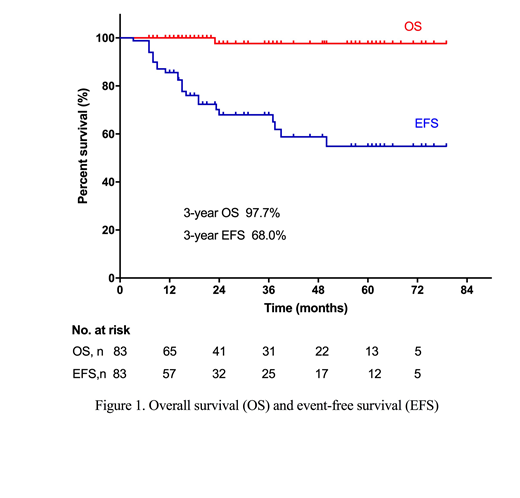
Backgroud: Langerhans cell histiocytosis (LCH) is a rare, heterogeneous histiocytic disorder occurring in patients of all ages from neonates to the elderly. The features of LCH are well described in children, however, they remain poorly defined in adults. There is no standard first-line treatment for adult LCH. The current standard treatment protocol for children is vinblastine plus prednisone, which has never been proven effective for adults in a prospective study. Considering the relatively high frequency of pituitary involvement and late onset of neurodegenerative symptoms, patients may benefit from the combination of cytarabine and methotrexate as both these drugs cross the blood-brain barrier.
Methods: This phase 2, prospective, single-center study enrolled 83 newly diagnosed adults multisystem (MS)-LCH or LCH with multifocal single system (SS-m) involved between January 2014 and March 2019 (NCT 02389400). The methotrexate (1g/m2by 24-hour infusion on day 1) and cytarabine (100 mg /m2by 24-hour infusion for 5 days) was administered every 35 days for a cycle and 6 cycles totally. The primary endpoint was event-free survival (EFS). Events were defined as a poor response to chemotherapy, reactivation after chemotherapy or death from any cause.
Results: The median age was 33 years (range 18-65 years). Forty-nine patients were male (59.0%). Six patients were SS-m LCH (7.2%), 77 patients were MS LCH (92.8%). The most common organ involved in the total cohort was bone (78.3%), followed by lung (67.5%), pituitary (62.7%) and lymph nodes (38.6%). Twenty-three patients had liver involvement (27.7%), 11 patients with spleen involvement (13.3%), no patients had hematologic involvement. All patients received at least one course of chemotherapy, with median 6 (1-6) courses. Overall 69 patients (83.1%) completed protocol treatment, 14 patients (16.9%) went off protocol (13 patients' decision, 1 poor response). The overall response rate was 87.9%. including 43 patients (51.8%) as having non-active disease and 30 patients (36.1%) as active disease (AD)/better. After a median of 23 months (range 7-79 months) follow-up, one patient died of disease progression and 25 patients had reactivation of the disease. The estimated 3-year OS and EFS were 97.7% and 68.0% separately (Figure 1). To evaluate the prognostic factors of EFS using univariate analysis, liver, spleen, lung and skin involvement at baseline had significantly shorter EFS. EFS were also evaluated using multivariate Cox regression model, liver involvement remained predictive of poorer EFS (P = 0.012; HR 0.339, 95% CI 0.146-0.784). The most common toxicity was hematologic adverse events. All patients experienced neutropenia and thrombocytopenia. Thirty-five patients (42.2%) had grade 4 neutropenia, 43 patients (51.8%) had grade 3 neutropenia. Fourteen patients (16.9%) had grade 4 thrombocytopenia, 13 patients (15.7%) had grade 3 thrombocytopenia. No patients received prophylactic antimicrobial treatment during any of the cycles. Forty patients (48.2%) experienced febrile neutropenia, including 38 (45.8%) grade 3 and 2 (2.4%) grade 4. The most common non-hematological toxicities were gastrointestinal complications. Two patients developed grade 3 nausea. Grade 3 alanine aminotransferase increased occurred in in two patients. No treatment related death. One patient had secondary primary malignancy (oral squamous cell carcinoma), 56 months after the last course of MA regimen. Fifty-two of 82 surviving patients experienced sequelae to the disease that were not influenced by therapy. Forty-eight patients had diabetes insipidus and 4 presented with hypothyroidism.
Conclusion: Methotrexate and cytarabine is an efficient and safe regimen for newly diagnosed adult LCH. The involvement of liver at baseline indicates a worse prognosis in adult LCH.
No relevant conflicts of interest to declare.
Author notes
Asterisk with author names denotes non-ASH members.

This icon denotes a clinically relevant abstract


This feature is available to Subscribers Only
Sign In or Create an Account Close Modal